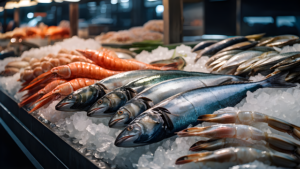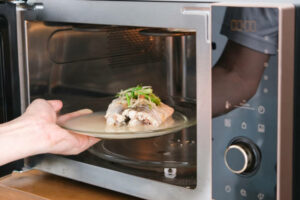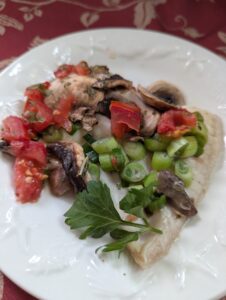Cook and Eat More Fish
go.ncsu.edu/readext?1072080
en Español / em Português
El inglés es el idioma de control de esta página. En la medida en que haya algún conflicto entre la traducción al inglés y la traducción, el inglés prevalece.
Al hacer clic en el enlace de traducción se activa un servicio de traducción gratuito para convertir la página al español. Al igual que con cualquier traducción por Internet, la conversión no es sensible al contexto y puede que no traduzca el texto en su significado original. NC State Extension no garantiza la exactitud del texto traducido. Por favor, tenga en cuenta que algunas aplicaciones y/o servicios pueden no funcionar como se espera cuando se traducen.
Português
Inglês é o idioma de controle desta página. Na medida que haja algum conflito entre o texto original em Inglês e a tradução, o Inglês prevalece.
Ao clicar no link de tradução, um serviço gratuito de tradução será ativado para converter a página para o Português. Como em qualquer tradução pela internet, a conversão não é sensivel ao contexto e pode não ocorrer a tradução para o significado orginal. O serviço de Extensão da Carolina do Norte (NC State Extension) não garante a exatidão do texto traduzido. Por favor, observe que algumas funções ou serviços podem não funcionar como esperado após a tradução.
English
English is the controlling language of this page. To the extent there is any conflict between the English text and the translation, English controls.
Clicking on the translation link activates a free translation service to convert the page to Spanish. As with any Internet translation, the conversion is not context-sensitive and may not translate the text to its original meaning. NC State Extension does not guarantee the accuracy of the translated text. Please note that some applications and/or services may not function as expected when translated.
Collapse ▲In last week’s column I mentioned that eating fish is like taking a multivitamin for your brain. It’s also good for your bones, heart and immune system. But, unfortunately only about 10% of Americans meet the recommendations that say we should be eating seafood twice a week.
 I think that one of the reasons that people don’t eat this recommended amount of seafood is that people don’t know how (or don’t like) to cook seafood at home. That’s a shame. Seafood is a versatile kitchen staple and can be prepared in a variety of ways. Experiment with different cooking methods like grilling, broiling or microwaving. Don’t forget to add some spices to enhance the flavor. This versatility can inspire you get creative in the kitchen and make seafood a regular in your diet.
I think that one of the reasons that people don’t eat this recommended amount of seafood is that people don’t know how (or don’t like) to cook seafood at home. That’s a shame. Seafood is a versatile kitchen staple and can be prepared in a variety of ways. Experiment with different cooking methods like grilling, broiling or microwaving. Don’t forget to add some spices to enhance the flavor. This versatility can inspire you get creative in the kitchen and make seafood a regular in your diet.
When it comes to seafood, safety is key. Keeping seafood refrigerated until ready to use and cooking fish and seafood to an internal temperature of 145°F is essential. Following these safety guidelines will ensure you and your family enjoy seafood with confidence and peace of mind, knowing you’re preparing it safely and healthily.
Thinking about cooking fish got me remembering microwave cooking classes I used to teach. There were a couple of recipes for fish that I used that were always class
favorites, not only because they were EASY but because they tasted great. I was able to find them in my cookbook collection.
 Fish cooks beautifully in the microwave because it is a moist cooking method. Since seafood is delicate and is naturally tender it has a short cooking time in the microwave. Try to cut fish pieces to be the same thickness—this will allow for even cooking. Place any thicker parts near the outside of the dish.
Fish cooks beautifully in the microwave because it is a moist cooking method. Since seafood is delicate and is naturally tender it has a short cooking time in the microwave. Try to cut fish pieces to be the same thickness—this will allow for even cooking. Place any thicker parts near the outside of the dish.
This first recipe comes from the cookbook that came with my very first microwave. It’s called Introduction to Touchmatic Cooking with the Amana Radarange. Believe-it-or-not copyright 1978. Those early microwaves had less wattage, so I would check the fish for doneness sooner, because newer microwaves will cook faster. The original recipe called for haddock, but you can use any fish you like.
Colorful Fillets

Colorful Fillets recipe, made with local flounder
- 1 pound of fish fillets, cut into serving-sized pieces
- 3 green onions sliced, keep some of the green
- 1 cup fresh mushrooms, sliced
- 1 cup tomatoes, chopped
- 1/8 teaspoon basil
- ¾ cup salt
- Dash pepper
Arrange fish is a single layer in an 8” square glass baking dish. Top with vegetables. Sprinkle with seasoning. Cover with plastic wrap. Place in microwave on HIGH power 3-4 minutes or until fish reaches 145 degrees and flakes easily with fork. Makes four servings with 136 calories each.
This second “throwback” recipe comes from a cookbook called Microwave Cooking Lite. Its copyright was in 1985. Back then any recipe that had added almonds were called “almondine”. Since the fish is very moist the almonds won’t get brown if added to the fish as it cooks, toast them before and sprinkle on the top after the fish is done. Again, with newer and higher wattage microwave oven, I’d watch both the almonds and the fish closely as they may cook faster than the original times.
Fillets Almondine
- ¼ cup sliced or slivered almonds
- 2 Tablespoons butter or margarine
- 1-1/2 pounds fish fillets, cut into serving-sized pieces
- ½ teaspoon salt
- 2 teaspoons lemon juice
Lemon slices for garnish (optional)
Combine almonds and butter/margarine in 8” square glass dish. Microwave on HIGH,
uncovered, 2-3 minutes or until golden brown, stirring once. Remove almonds with
slotted spoon and set aside.
Add the fish fillets to the butter/margarine, turning to coat both sides. Cover with plastic wrap. Microwave on HIGH 6-7 minutes until fish is 145 degrees and flaky. Rotate the dish once. Sprinkle with salt, lemon juice and almonds. Garnish with lemon slice. Makes 6 servings, 160 calories each.
Again, I challenge you to try some new (or old) recipes and work to eat fish and seafood at least twice a week.
Syracuse is a Family and Consumer Science team member and can be reached at N.C. Cooperative Extension, Brunswick County Center 910-253-2610 or by email at clsyracu@ncsu.edu



